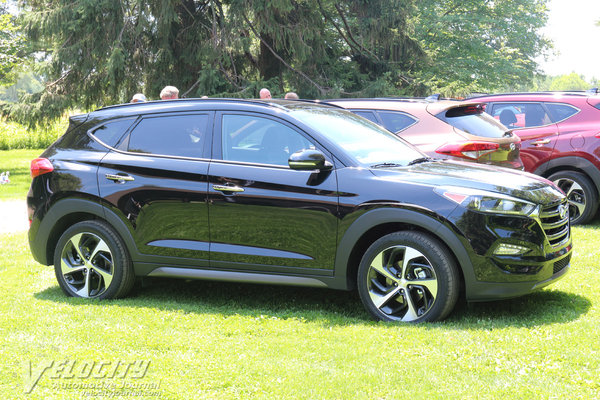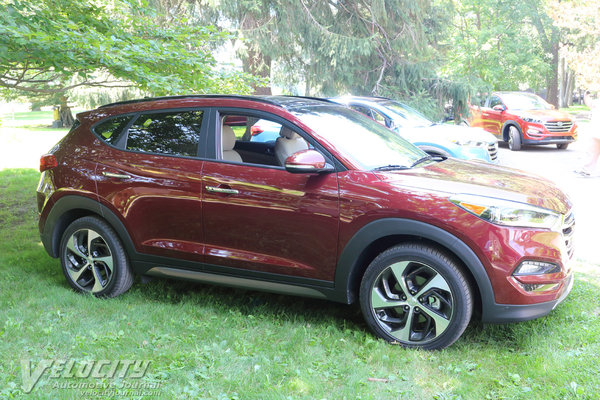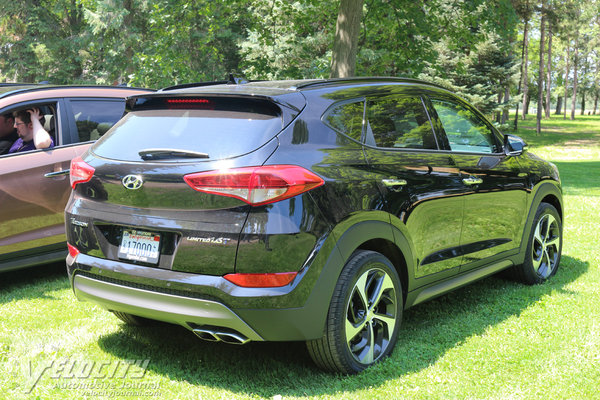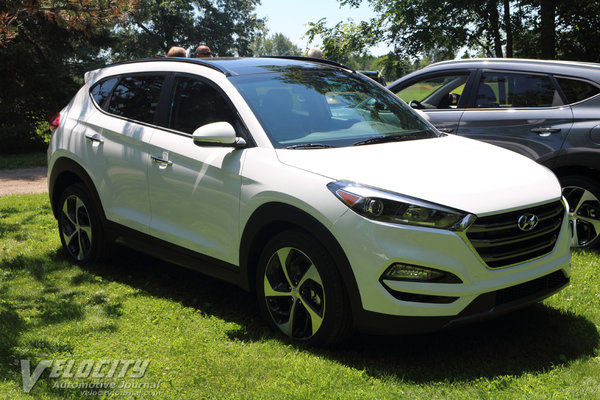2016 Hyundai Tucson
08/22/2015
Shahed Hussain
Among compact SUVs, the Hyundai Tucson has been outshone by its Japanese and American competition. To catch up in this rapidly evolving segment, Hyundai completely redesigned the 2016 Tucson to bring it on par with the CR-V, RAV4, Escape, Rogue and Equinox. Hyundai also revised the Tucson model range starting with the base SE ($22,700), followed by the ECO ($24,150), Sport ($26,150), and Limited ($29,900). All wheel drive is available on all Tucsons for an additional $1,400.
The Tucson's interior is conservatively styled in predominantly gray hues. Silver vent surrounds and console trim contrast with all the gray panels. Gauges have clear white-on-black markings and consist of a speedometer, tachometer, along with smaller fuel and coolant temperature indicators. A central driver information display shows vehicle and trip computer data. A leather-wrapped steering wheel is standard on the Sport and Limited models. The standard 6-speaker sound system supports MP3 audio and includes a 5-inch touchscreen. Opt for the Tucson Limited to get the 405-watt, 8-speaker system and 8-inch touchscreen plus navigation.
Cloth seats are standard on the Tucson Sport, but the Limited gets perforated leather. Heated front seats are standard on the Sport and Limited; ventilated front seats are an option on the Limited. Even the base Tucson SE has a 6-way power adjustable driver's seat. Other models have 8-way power adjustment with lumbar support. The Tucson Limited adds power seat settings for the front passenger. After sampling the cloth and leather seats in the Tucson Sport and Limited, respectively, we found both to be comfortable with decent lateral support.
Replacing the previous Tucson's 2.4L inline-4 is a new 1.6L turbo four cylinder engine. The 2.0L normally aspirated inline-4 remains the base engine. Both powerplants have continuously variable valve-timing (CVVT) and dual overhead cams. The 2.0L is rated at 164-bhp @ 6,200 RPM and a torque peak of 151 lb.-ft. @ 4,000 RPM. For the 1.6L turbo, Hyundai claims 175-bhp @ 5,500 RPM and 195 lb.-ft. of torque between 1,500 and 4,500 RPM. The old 2.4L was rated at up to 182-bhp and 177 lb.-ft. so the downsized 1.6L turbo loses some peak horsepower to gain additional torque.
As before, the 2.0L four is coupled with a 6-speed automatic. All other Tucsons are equipped with the 1.6L turbo, mated to a 7-speed dual-clutch automatic. The 6-speed is a conventional torque converter automatic with an overdrive sixth gear. The 7-speed dual-clutch unit has overdrive ratios for fifth (0.822:1) through seventh (0.721:1). On AWD models, the driver can select manual AWD lock or leave the driveline in the active on-demand mode.
According the Hyundai, the front-drive Tucson SE achieves 23/31 MPG (city/hwy.), while the ECO ekes out 26/33 MPG (city/hwy.). Both Sport and Limited models are rated at 25/30 MPG (city/hwy.). Opting for all-wheel drive drops 1-2 MPG with the 1.6L turbo, but the 2.0L loses 5 MPG on the highway. For comparison, the old 2.4L and AWD combination was rated at 20/25 MPG (city/hwy.), so Hyundai's decision to adopt the turbo four and the 7-speed automatic results in a substantial improvement in EPA fuel economy.
Like most other compact SUVs, the Tucson uses a MacPherson front suspension with a stabilizer bar, and a multi-link rear layout with coil springs, dampers, and a stabilizer. The rack-and-pinion steering is electrically assisted with 2.71 turns lock-to-lock. Brakes are all discs with 12.0 in. diameter vented front rotors and 11.9 in. diameter rear rotors. ABS, electronic stability control (ESC) and traction control are standard. Tucson SE and Eco models get 17 in. diameter alloy wheels with 225/60R17 tires. Move up to the Tucson Sport and Limited and Hyundai substitutes 19 in. diameter alloy wheels and wider 245/45HR19 tires. Curb weight ranges from 3,325 lbs. (2.0L FWD) to 3,710 lbs. (1.6L AWD).
During the press preview, we drove the front-drive Tucson Sport and Limited models. The Sport has a tightly damped firm ride that is jittery over bumpy roads. On smooth pavement, ride control is exemplary, especially for a compact SUV. In contrast, the Tucson Limited's suspension is tuned for a more relaxed, comfortable ride that soaks up bumps more readily than the stiffly sprung Sport. Although the 19-inch diameter alloy wheels in the Sport and Limited are attractive, we think that the smaller 17-inch diameter wheels in the SE and ECO will provide a superior ride.
On the highway, wind, engine, and tire noise are pleasantly subdued, making the Tucson suitable for long road trips. The 1.6L turbo has decent throttle response above 2,000 RPM, but below that threshold turbo lag delays peak torque availability. Torque steer in a FWD Tucson is negligible; a full throttle launch results in a barely felt tug at the wheel. The dual-clutch automatic shifts seamlessly in normal driving, but downshifts at full throttle are slower than expected. We could use the console shifter for manual shifts, but steering wheel-mounted paddle shifters would be appreciated by Tucson Sport customers. The electrically-assisted steering is communicative and delivers decent off-center response. Moderate understeer is typical for compact SUVs, and the Tucson has no surprises here. The Tucson Sport's stiffer suspension minimizes body roll goes compared to the Limited's softer spring settings. A firm brake pedal and the all-disc brakes delivered confident stops. If we lived in a region with decent roads, the Tucson Sport would be our choice, but on the patched and potholed Detroit highways the other Tucson models would be easier to live with on a daily basis.
Hyundai has steadily transformed the Tucson from a basic compact SUV into a credible alternative to the Japanese and American segment leaders. The Tucson gives up nothing to rival SUVs in technology and refinement, but does distinguish itself with a comprehensive standard equipment list at an attractive price. We think that the Tucson ECO and Sport are the best values in the lineup, but price-sensitive customers should consider the front-drive Tucson SE too.




